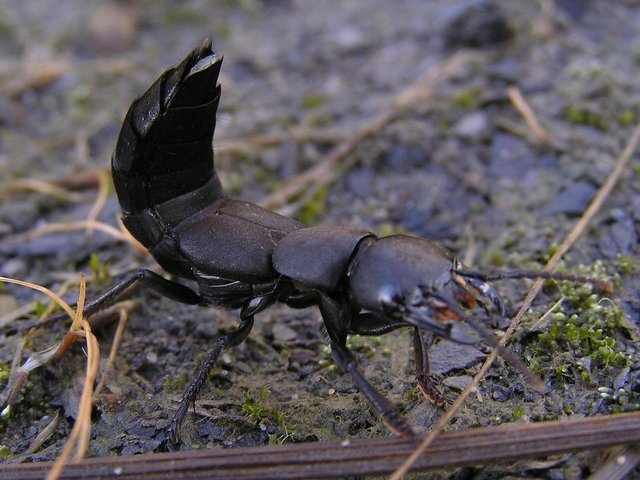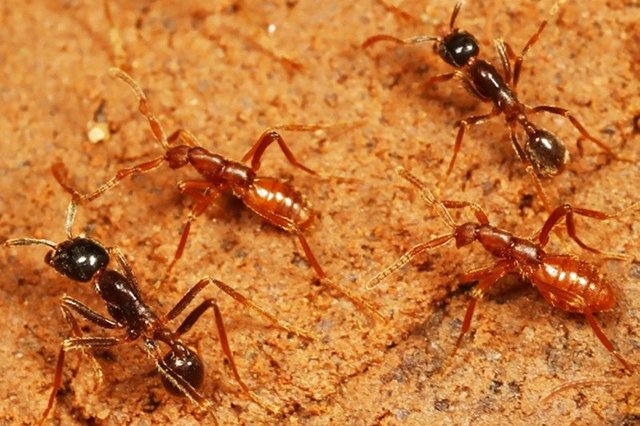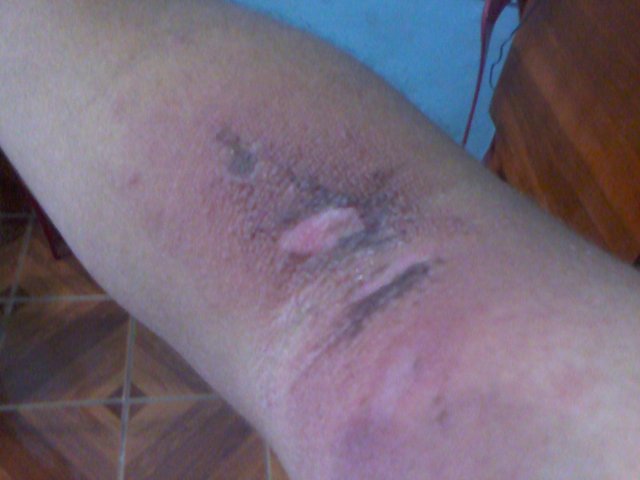Causin more harm than good: Rove Beetle
Some couple of weeks back, my friends and I went out camping in the wild wild west (okay not that wild but yes, west of Nigeria we were.). It was quite hip and fun then night came - you know the part of camping where you create a camp fire from woods and sit around, well we decided to go "new school" and brought 5 bright fluorescent rechargeable lamps instead of burning trees (pretty dumb idea but it felt like a smart move at the time). So we turnt on the lamps and in a matter of minutes, we were not alone anymore. Putting on the lamps was like sending out invitations to our neighbouring ecosystem of insects and what not to come join the party - and they never disappointed. They came in large numbers with their "dancing shoes" and almost crashed our camping. To cut the story short, we later decided to burn woods to create fire and went medieval on our unwanted guests, but the damage has been done already.
Now you may ask "what damage? You all went home and lived happily ever after right?" Yes, we all got home alright but after about 24 hours of our little adventure, some of my friends started developing some sort of strange rash (according to them) on their body and somehow by some miracle I didn't. So I went to see one of them with the rash and what I saw wasn't so strange at all, in fact, I've had my own brief encounter with this so-called "strange" rash and I knew immediately who (or what in this case) the culprit was. Staphylinidae paederinae
Staphylinidae paederinae
,_imago.jpg) Source: Wikimedia Commons Author: Gubin Olexander License: CC BY-SA 3.0
Source: Wikimedia Commons Author: Gubin Olexander License: CC BY-SA 3.0
Staphylinidae paederinae are commonly known as "rove beetles". Over the years, they have been identified with different aliases in different parts of the world; alias "Charlie ant" in Australia, "Skirt and Blouse" in Nigeria and many more. They come from a family of Staphylinidae beetles. They are an ecological and morphological diverse species of about 58,000 species in thousands of genera and this fact alone makes them one of the largest family of beetles and can be found mostly on land. They are mostly found in the Middle East, Africa, Asia, South America, North America and Australia.
Anatomy
Considering they are such a large family, the anatomy among species varies widely as they have an elongated body that ranges between <1 to 35mm and their colours range from yellow to reddish-brown to brown and to black. They have segmented antennae and their abdomen are usually long and flexible - some species of rove beetles are known to protrude their abdomen like a scorpion when they are agitated. Ocypus sp. Wiki Commons By Daniel Ullrich. License: CC BY-SA 3.0
Ocypus sp. Wiki Commons By Daniel Ullrich. License: CC BY-SA 3.0
They have a thick thorax which is usually yellow or orange (sometimes black) in colour and protruding long limbs that helps in their mimicry of ants. They have wings which are well concealed beneath the body. They are predators that can be found just about in any habitat you can find beetles.
Beneficial or Harmful to us?
This may come as a surprise, but they are both beneficial and harmful depending on your approach.
Rove beetles feed on just about anything except for the living tissues of higher plants. But most species of rove beetles are predators as they feast on other insects especially ants. These particular specie of rove beetle are quite "sneaky and cunny" in the sense that they have quite gone through quite an evolution to modify their body form to resemble that of their prey (ants), so they can blend in with their prey.  Rove beetles mingling with ants. source Author: Taku Shimada
Rove beetles mingling with ants. source Author: Taku Shimada
In the journal "Deep-time convergence in rove beetle symbionts of army ants" by Munetoshi Maruyama and Joseph Parker, they demonstrated that many species of rove beetle exhibit myrmecoid (ant-like) body forms thereby deceiving their hosts into accepting them into their colonies, emigrating and cohabitating with the host, working and feeding with the workers but in the process also feeding on the ant population.
This little predatory relationship between rove beetles and other insects has been well exploited by humans in controlling pests in small gardens. They feed on small insects and mites found on plant roots, thereby eliminating them and once all the pest are eliminated, the rove beetles leave the garden themselves in search of "greener pastures".
On the other hand, some species can be harmful to humans (especially the genus: Paederus). Their hemolymph contains a toxic vesicant "pederin" which is considered to be more toxic than cobra's venom - no shit
 Chemical structure of "pederin"
Chemical structure of "pederin"
Wiki Commons By Edgar181 License: CC BY-SA 3.0
Pederin which is ~1% of the insect's body weight is highly toxic once it touches the surface of the skin causing an apoptotic effect on the contaminated cells in the basal and suprabasal layers of the dermis producing a contagious skin lesion called "dermatitis linearis"
It is contagious when the pulse-like liquid from the rash is transferred to another skin surface, thereby producing similar irritation without prior contact with the rove beetle's hemolymph.
Pederin is introduced to the human skin not by biting or stinging (as rove beetles don't bite or sting) but by crushing of the beetle against the skin, hence the hemolymph contacts the skin. Paederus dermatitis lesion on the arm Source: Wiki Commons Author: Vilmer22 License: CC BY-SA 3.0
Paederus dermatitis lesion on the arm Source: Wiki Commons Author: Vilmer22 License: CC BY-SA 3.0
Brooke A. Beaulieu and Seth R. Irish in their journal "Literature review of the causes, treatment, and prevention of dermatitis linearis" reported that:
Pederin is not synthesized by the beetle itself, but is produced instead by an endosymbiotic Pseudomonas gram-negative bacteria.
Precautions and recommendations against Paederus dermititis
As the saying goes "prevention is better than cure" it is best to stay away from direct artificial light source outside as rove beetles like all insects are attracted to bright light. And inevitably you probably encounter one, it is best to blow or wash them away rather than swatting them against your skin.
In some cases, people unconsciously crush these little "devils" and wake up with a sore reddened blister across the skin, if this is you as it was my friends don't worry, though Paederus dermatitis has no apparent cure, but several studies had shown that topical corticosteroid helps to relieve the pain and reduce the swelling. Results has shown that lotions made from Sambucus ebulus soothes itchiness and reduces inflammation.
The contaminated skin usually heals by itself as the toxin wears away gradually and this usually take between 1 to 4 weeks depending on area of exposure and severity.
In extreme cases, such as exposure to sensitive areas like the genitalia intravenous steroids are usually administered.
The best advice I got for you like I gave my friend, is not to itch it no matter how strong the urge is, it only makes matter worse.
Conclusion
Rove beetle is famously known for its harm (Paederus dermatitis) than good (pest-control). So while you may consider using this conniving bunch of ant-like predators to eradicate tiny pests in your little garden, you best be careful not to let them in your house unless you are itching for a scar on your pretty face, then go ahead and leave the door open. Otherwise it is better to take precautionary measures to keep them "buggers" out of your house and face- as they are known to sneak up on people's bed and wait for you to crush them.
And since mistakes happen, you unfortunately squashed one on your skin, quickly wash the surface with soap and cold water, and hope to God you washed it all.
Thank you for your time and attention. Till next time, friend.
References
- Literature review of the causes, treatment, and prevention of dermatitis linearis journal of travel medicine, volume 23, issue 4. By Brooke A. Beaulieu and Seth R. Irish
- Deep-time convergence in Rove beetle symbionts of army ants By Munetoshi Maruyama and Joseph Parker.
- Life History Characteristics of the Rove Beetle, Dalotia coriaria (Coleóptera: Staphylinidae) under Laboratory Conditions by Erik R. Echegaray and Raymond A. Cloyd Journal of the Kansas Entomological Society Vol. 86, No. 2 (APRIL 2013), pp. 145-154.
- Clinical Presentation of “Rove Beetle Dermatitis Australasian Medical Journal Vol 1 by Khan Tahir et al.
- Rove beetle facts by Jackie Carol
- Wikipedia
Hi @moshroom!
Your post was upvoted by utopian.io in cooperation with steemstem - supporting knowledge, innovation and technological advancement on the Steem Blockchain.
Contribute to Open Source with utopian.io
Learn how to contribute on our website and join the new open source economy.
Want to chat? Join the Utopian Community on Discord https://discord.gg/h52nFrV
This post has been voted on by the steemstem curation team and voting trail.
There is more to SteemSTEM than just writing posts, check here for some more tips on being a community member. You can also join our discord here to get to know the rest of the community!
Congratulations @moshroom! You have completed the following achievement on Steemit and have been rewarded with new badge(s) :
Click on the badge to view your Board of Honor.
If you no longer want to receive notifications, reply to this comment with the word
STOPDo not miss the last post from @steemitboard:
SteemitBoard World Cup Contest - Home stretch to the finals. Do not miss them!
Participate in the SteemitBoard World Cup Contest!
Collect World Cup badges and win free SBD
Support the Gold Sponsors of the contest: @good-karma and @lukestokes